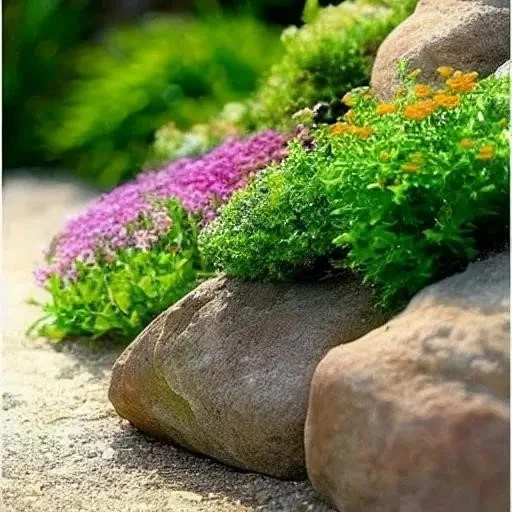In an era increasingly defined by our quest for sustainable living and aesthetic harmony, a remarkable trend is taking root in gardens worldwide: the rock flower garden․ Far more than just an arrangement of stones and blossoms, these captivating landscapes represent a profound fusion of art and ecology, offering a breathtaking tableau that thrives with minimal intervention․ Imagine a vibrant tapestry of resilient flora, elegantly nestled amidst ancient, weathered rocks, creating a serene sanctuary right in your own backyard․ This isn’t merely about landscaping; it’s about cultivating a miniature ecosystem, a testament to nature’s enduring beauty and our ability to co-create with it․
Driven by a burgeoning desire for low-maintenance yet visually stunning outdoor spaces, homeowners and landscape designers are increasingly turning to this innovative approach․ Rock flower gardens, also known as alpine gardens or xeriscapes, are incredibly effective at conserving water, reducing the need for constant watering and chemical inputs․ They stand as vibrant symbols of ecological responsibility, offering not only unparalleled beauty but also a practical, forward-thinking solution for modern living․ By embracing this artful blend of geology and botany, you embark on a rewarding journey, transforming barren patches into thriving havens that inspire awe and tranquility․
| Key Aspects of a Successful Rock Flower Garden | |
|---|---|
| Core Concept | A landscape design integrating rocks and drought-tolerant, often alpine or succulent, plants to create a low-maintenance, ecologically sound, and visually striking garden․ |
| Primary Benefits | Water conservation (xeriscaping), reduced maintenance, enhanced biodiversity, year-round visual interest, resilience to harsh conditions, and a naturalistic aesthetic․ |
| Essential Components | Varied rocks (limestone, sandstone, granite), well-draining soil mix (gritty, sandy), appropriate plant selection (alpines, succulents, dwarf conifers, ornamental grasses), and proper site preparation (drainage)․ |
| Ideal Plant Characteristics | Hardy, drought-tolerant, compact growth habit, prefers lean soil, and thrives in sun exposure․ Examples include Sedum, Sempervivum, creeping Phlox, and various dwarf evergreens․ |
| Maintenance Level | Generally low once established, requiring minimal watering, occasional weeding, and light pruning․ |
| Environmental Impact | Significantly reduces water usage, decreases reliance on fertilizers and pesticides, supports local pollinators, and contributes to sustainable landscaping practices․ |
| Reference Link | Royal Horticultural Society ─ Rock Garden Guide (A comprehensive resource for gardening enthusiasts․) |
The Art of Design: Crafting Your Vision
Creating a truly remarkable rock flower garden begins with thoughtful planning․ It’s akin to an artist sketching their masterpiece, considering every contour and shade․ Site selection is paramount; most rock garden plants crave ample sunlight and excellent drainage․ Observe your chosen area throughout the day, assessing its sun exposure and identifying any natural slopes that can be leveraged to enhance water runoff․ By integrating insights from successful xeriscaping principles, you can strategically position larger rocks to mimic natural outcrops, forming pockets and crevices that provide microclimates for diverse plant life․ This meticulous approach ensures both aesthetic appeal and horticultural success, laying a robust foundation for your living art installation․
Selecting your rocks is a pivotal step, influencing the garden’s overall character․ Opt for local stone if possible, as it naturally harmonizes with the surrounding landscape․ Varying sizes and shapes are incredibly effective in creating a naturalistic feel; think of a riverbed, where smooth pebbles mingle with larger, craggy boulders․ Strategically placing these stones, partially burying larger ones to simulate natural erosion, adds an authentic, aged beauty․ This process isn’t merely about arranging; it’s about sculpting with nature’s building blocks, giving your garden an enduring, geological presence that feels both ancient and alive․
Cultivating Resilience: Soil, Plants, and Expert Insights
The secret to a thriving rock garden lies beneath the surface: the soil․ Unlike traditional garden beds, rock gardens demand a lean, gritty, and exceptionally well-draining substrate․ A common mixture comprises equal parts sharp sand, grit, and loam, sometimes with a touch of compost for essential nutrients, but sparingly to prevent excessive richness․ This specialized blend mimics the harsh, well-aerated conditions found in mountainous regions, encouraging roots to seek out moisture and nutrients deeply, thereby fostering robust, resilient growth․ Preparing this foundation meticulously will significantly impact the long-term vitality of your chosen flora․
Plant selection is where your garden truly comes alive, showcasing a breathtaking diversity of form and texture․ Expert horticulturists often recommend a palette of alpine plants, succulents, dwarf conifers, and creeping perennials․ Consider hardy Sedums and Sempervivums for their architectural beauty and drought tolerance, or the vibrant blooms of creeping Phlox and Dianthus that spill over rocks like miniature waterfalls․ Incorporating dwarf ornamental grasses can add a dynamic, windswept quality, while tiny bulbs like Crocus or Scilla offer surprising bursts of color in early spring․ The key is to choose plants that are not only beautiful but also adapted to the specific conditions of your rockery, ensuring their flourishing existence․
According to Dr․ Eleanor Vance, a renowned botanist specializing in alpine flora, “The true genius of a rock garden lies in its capacity to replicate nature’s rugged elegance; By understanding the specific needs of these incredibly resilient plants – their preference for sharp drainage, lean soil, and good air circulation – we can create truly sustainable and breathtaking landscapes․ It’s a testament to how intelligent design can unlock nature’s inherent beauty․” Industry examples abound, from the meticulously crafted alpine houses at Kew Gardens to private estates showcasing expansive rockeries, all demonstrating the profound impact of this specialized gardening approach․ These examples serve as powerful inspiration, illustrating what is remarkably achievable with thoughtful execution․
The Future Blooms: A Sustainable Legacy
The journey of creating a rock flower garden is one of discovery and profound connection to the natural world․ It’s a forward-looking endeavor, offering not just an immediate aesthetic reward but also contributing significantly to ecological sustainability․ As climate patterns shift and resource conservation becomes increasingly critical, these resilient landscapes offer a persuasive model for future gardening․ They minimize water usage, reduce chemical reliance, and provide crucial habitats for local wildlife, fostering biodiversity right in our urban and suburban environments․ With each carefully placed stone and every thriving plant, you are not merely gardening; you are actively participating in a movement towards a more beautiful, more resilient, and more sustainable future․
Embrace the challenge, revel in the process, and witness the incredible transformation of your outdoor space into a vibrant, living masterpiece․ Your rock flower garden will stand as a testament to your vision, a tranquil haven that will enchant for years to come, proving that paradise can indeed be unsealed in the most unexpected and enduring ways․






